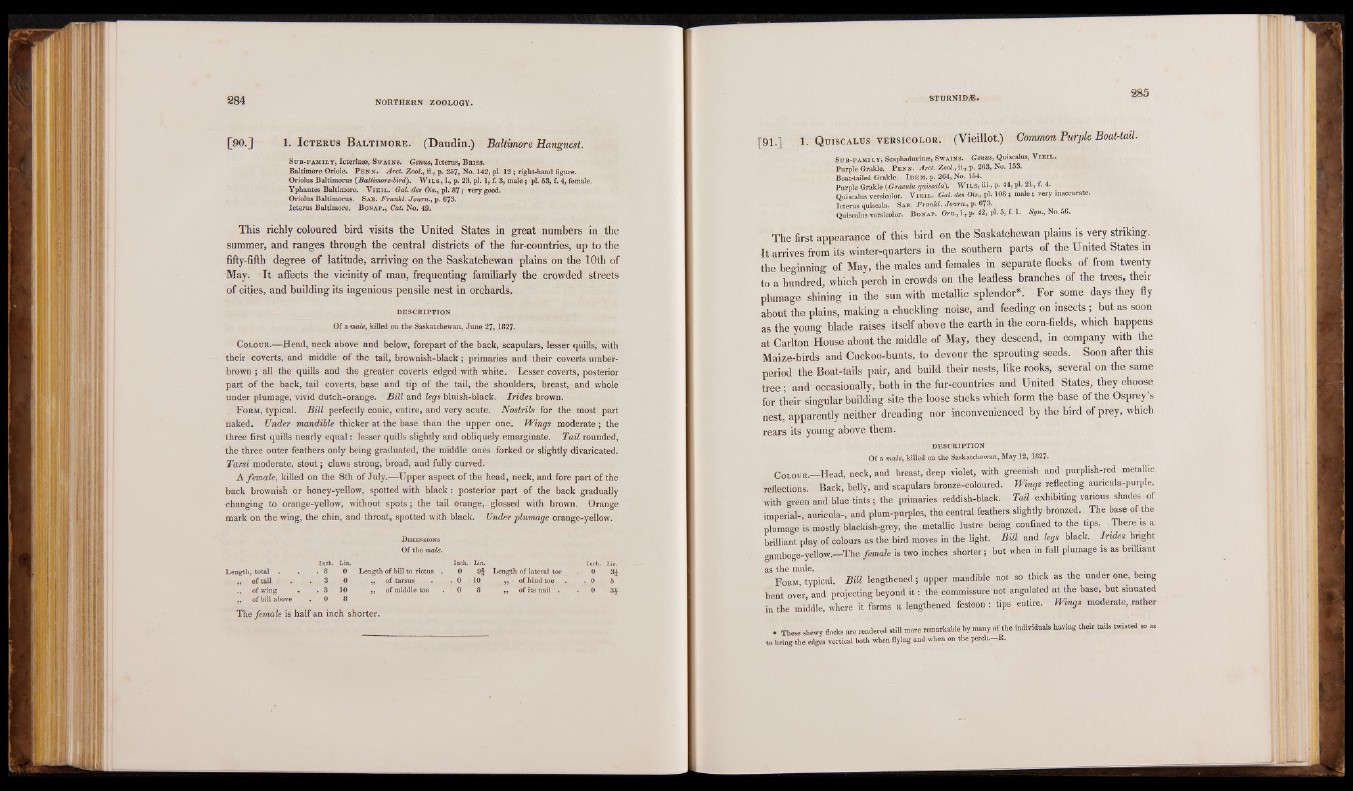
[90.] 1. Icterus Baltimore. (Daudin.) Baltimore Hangnest.
Su b -f a m il y , Icterinse, Sw a in s . Genus, Icterus, B r iss.
Baltimore Oriole. P enn. Arct. Zool., ii., p. 257, No. 142, pi. 12; right-hand figure.
Oriolus Baltimorus (Baltimore-bird). Wils., i., p. 23, pi. 1, f. 3, male; pi. 53, f. 4, female.
Yphantes Baltimore. Vie il . Gal. des Ois., pi. 87; very good.
Oriolus Baltimorus. Sab. Frarikl. Journ., p. 673.
Icterus Baltimore. B on ap., Cat. No. 49.
This richly coloured bird visits the United States in great numbers in the
summer, and ranges through the central districts of the fur-countries, up to the
fifty-fifth degree of latitude, arriving on the Saskatchewan plains on the 10th of
May. It affects the vicinity of man, frequenting familiarly the crowded streets
of cities, and building its ingenious pensile nest in orchards.
DESCRIPTION
Of a male, killed on the Saskatchewan, June 27, 1627*
C olour.—Head, neck above and below, forepart of the back, scapulars, lesser quills, with
their coverts, and middle of the tail, brownish-black; primaries and their coverts umber-
brown; all the quills and the greater coverts edged with white. Lesser coverts, posterior
part of the back, tail coverts, base and tip of the tail, the shoulders, breast, and whole
under plumage, vivid dutch-orange. Bill and legs bluish-black. Irides brown.
Form, typical. Bill perfectly conic, entire, and very acute. Nostrils for the most; part
naked. Under mandible thicker at the base than the upper one. Wings moderate; the
three first quills nearly equal: lesser quills slightly and obliquely emarginate. Tail rounded,
the three outer feathers only being graduated, the middle ones forked or slightly divaricated.
Tarsi moderate, stout; claws strong, broad, and fully curved.
A female, killed on the 8th of July.—Upper aspect of the head, neck, and fore part of the
back brownish or honey-yellow, spotted with black: posterior part of the back gradually
changing to orange-yellow, without spots; the tail orange, glossed with brown. Orange
mark on the wing, the chin, and throat, spotted with black. Under plumage orange-yellow.
Dimensions
Of the male.
Inch. Lin. Inch. Lin. Inch. Lin.
Length, total . . 8 0 Length of bill to rictus . 0 9 f Length of lateral toe 0 3£
„ of tail r . 3 0 . ,, of tarsus . 0 10 , „ of hind toe . 0 5
of wing . 3 10 „ of middle toe 0 8 „ of its nail . • 0 3*
„ of bill above . 0 8
The female is half an inch shorter.
[91.] 1. Q u isc a l u s v e r s ic o l o r . (Vieillot.) Common Purple Boat-tail.
Su b -f a m il y , Scaphadurinae, Sw a in s. Genus, Quiscalus, V i e i l .
Purple Grakle. P e n n . Arct. Zool., ii., p. 263, No. 153.
Boat-tailed Grakle. Idem, p. 264, No. L54.
Purple Grakle (Gracula quiscala). W il s , iii., p- 44, pi. 21, f. 4.
Quiscalus versicolor. V i e i l . Gal. des Ois., pi. 108; male; very inaccurate.
Icterus quiscala. Sa b . Fra-nkl. Joum., p.673.
Quiscalus versicolor. B o n a p. Orn., i., p. 42, pi. 5, f. 1. Syn., No. 56.
The first appearance of this bird on the Saskatchewan plains is very striking.
I t arrives from its winter-quarters in the southern parts of the United States in
the beginning of May, the males and females in separate flocks of from twenty
to a hundred, which perch in crowds on the leafless branches of the trees, their
plumage shining in the sun with metallic splendor*. For some days they fly
about the plains, making a chuckling noise, and feeding on insects; but as soon
as the young blade raises itself above the earth in the corn-fields, which happens
at Carlton House about the middle of May, they descend, in company with the
Maize-birds and Cuckoo-bunts, to devour the sprouting seeds. Soon after this
period the Boat-tails pair, and build their nests, like rooks, several on the same
tree; and occasionally, both in the fur-countries and United States, they choose
for their singular building site the loose sticks which form the base of the Osprey’s
nest, apparently neither dreading nor inconvenienced by the bird of prey, which
rears its young above them.
DESCRIPTION
Of a male, killed on the Saskatchewan, May 12, 1827.
C olour.__Head, neck, and breast, deep violet, with greenish and purplish-red metallic
reflections. Back, belly, and scapulars bronze-coloured. Wings reflecting auricula-purple,
with green and blue tints; the primaries reddish-black. Tail exhibiting various shades of
imperial-, auricula-, and plum-purples, the central feathers slightly bronzed. The base of the
plumage I mostly blackish-grey, the metallic lustre being confined to the tips. There is a
brilliant play of colours as the bird moves in the light. Bill and legs black. Irides bright
gamboge-yellow.—The female is two inches shorter; but when in full plumage is as brilliant
as the male. ,. , , . F oem, typical. Bill lengthened; upper mandible not so thick as the under one, being
bent over and projecting beyond it: the commissure not angulated at the base, but sinuated
in the middle, where it forms a lengthened festoon: tips entire. Wings moderate, rather
. These shewy Seeks are rendered stffl more remarkable by many of the individuals having their taila twisted so as
to bring the edges vertioal both when flying and when on the perch.—R.